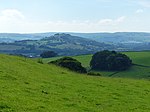Peak Forest Tramway

The Peak Forest Tramway was an early horse- and gravity-powered industrial railway (or tramway) system in Derbyshire, England. Opened for trade on 31 August 1796, it remained in operation until the 1920s. Much of the route and the structures associated with the line remain. The western section of the line is now the route of the Peak Forest Tramway Trail.The tramway was originally planned to be about 4 miles (6 kilometres) long from Chapel Milton to Dove Holes. However, it was decided to start the tramway at Bugsworth (now called Buxworth) and, as built, it was about 6 miles (10 kilometres) long. Its purpose was to carry limestone from the vast quarries around Dove Holes down to Bugsworth Basin via Chapel-en-le-Frith and Chinley, where much of it was taken by boat along the Peak Forest Canal and the Ashton Canal to Manchester and beyond. The remaining limestone was put into lime kilns at Bugsworth where it was converted into quick lime (or burnt lime).
Excerpt from the Wikipedia article Peak Forest Tramway (License: CC BY-SA 3.0, Authors, Images).Peak Forest Tramway
Brookside, High Peak Chinley, Buxworth and Brownside
Geographical coordinates (GPS) Address Nearby Places Show on map
Geographical coordinates (GPS)
| Latitude | Longitude |
|---|---|
| N 53.3354 ° | E -1.969 ° |
Address
Bugsworth Basin Rubbish Disposal
Brookside
SK23 7NE High Peak, Chinley, Buxworth and Brownside
England, United Kingdom
Open on Google Maps









